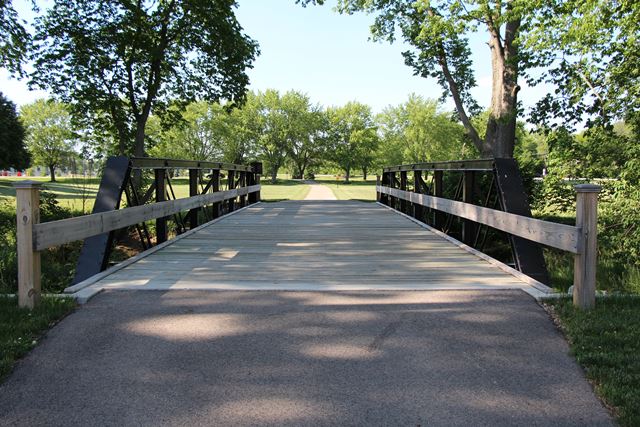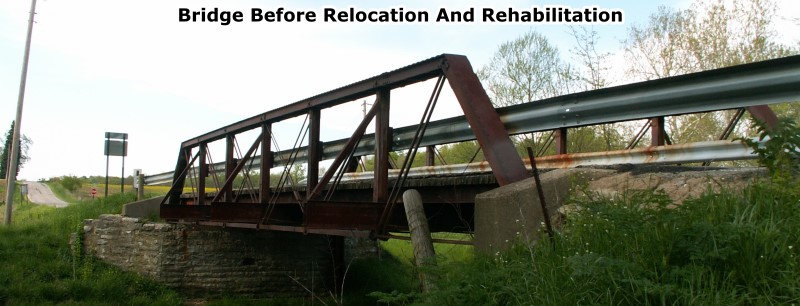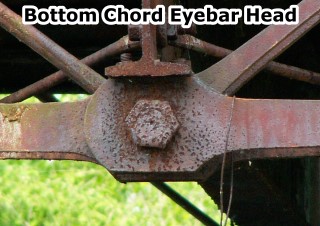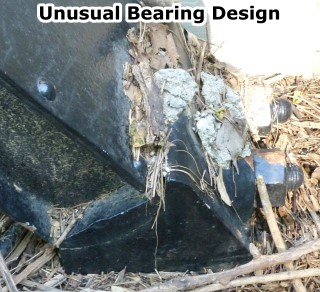We Recommend:
Bach Steel - Experts at historic truss bridge restoration.
BridgeHunter.com Phase 1 is released to the public! - Visit Now
Fairview-Snodgrass Road Bridge

Primary Photographer(s): Nathan Holth
Bridge Documented: May 7, 2006 and June 6, 2014
Near Troy: Miami County, Ohio: United States
By Builder/Contractor: Smith Bridge Company of Toledo, Ohio
2011
67.0 Feet (20.4 Meters)
69.0 Feet (21 Meters)
15.4 Feet (4.69 Meters)
1 Main Span(s)
5531055

View Information About HSR Ratings
Bridge Documentation
View Archived National Bridge Inventory Report - Has Additional Details and Evaluation
Observations in 2006
This is a six panel pin connected half-hip Pratt pony truss. This is a decent length for a half-hip bridge, and the bridge has an unusually large number of panels for this length. The trusses are not very deep (tall) looking for a bridge of this length, but this is partly an illusion because the floor beams for this bridge rest on top of the bottom chord eyebar heads, rather than being positioned below the deck via u-bolt hangers. This had the effect of raising the roadway up a bit. This bridge has substantial loss of historic integrity. The floor beams are replacements and the way they rest on the bottom chord is likely not how the original floor beams were positioned. The original floor beams were likely hung from u-bolt hangers. The most substantial alteration however is that all the verticals were replaced with rolled i-beams in 1954. Apparently this is also when the floorbeams were added. Finally, outriggers also appear to have been added to the bridge at this time. Also, original railings do not remain on the bridge.
In 2006, on Fairview Snodgrass Road, the deck of the bridge was wooden with an asphalt wearing surface. The abutments were originally stone, but concrete had been added in places. On another note, in 2006, sections of what looked like a truss bridge top chord or end post were found laying under the bridge. One was leaning up against the abutment, and another was laying on the dirt near the abutment. The top chord and end posts of the Fairview-Snodgrass Road Bridge are original so apparently these beams came from some other bridge that was demolished.
Despite alteration, the top chord, diagonals and bottom chord are original to the period of pin-connected truss bridges. The bridge still conveys information about how bridge's of the past were built, and the bridge is far more interesting to look at than any modern bridge. The bridge as a result still has heritage value. It was perhaps with this thinking that this bridge was lucky enough to be preserved.
2011 Relocation and Rehabilitation

HistoricBridges.org photo-documented this bridge in its original location, crossing Spring Creek in Miami County in 2006. Later, in 2011, the bridge was relocated and restored for pedestrian use on a non-motorized trail north of Troy Ohio. The main map page for this bridge reflects the current location of the bridge. To see the former, original location of the bridge click here. A photo of the bridge relocated and being restored is shown below. Photo courtesy Tom Barrett, Ohio Department of Transportation.
HistoricBridges.org visited and re-documented the bridge in its new location in 2014. The bridge is a great example of historic bridge preservation, and Miami County's efforts were recognized with an award from ODOT.
Construction Date and Builder of the Bridge

The National Bridge Inventory gave a 1913 construction date for this bridge and a 1954 rehabilitation date. As those familiar with pin-connected truss bridges know, 1913 is suspiciously late for a pin-connected truss. The story of this bridge is a bit more complicated.
Paul P. Huelskamp, Miami County Engineer provided the following explanation:
"According to the local lore regarding this bridge, it and its sister bridge around the corner on Statler Road, were both damaged/washed out in 1913. A new pony truss was installed on Statler Road in 1913 (a riveted truss that was ultimately replaced in 1997 with a prestress concrete box beam structure) and pieces/parts from the two damaged bridges, were used to erect the bridge on Fairview Road in 1913. So I agree that the parts are older than 1913. It was, however, erected as a unit on Fairview Road in 1913."
This history makes it somewhat complicated to describe typical bridge key facts like "construction date" and "bridge builder" since it has parts from multiple bridges, plus major alterations in 1913. That said, field observations of the bridge's parts reveal that a large portion of the trusses are composed of what appears to have originally been a pony truss built by the Smith Bridge Company of Toledo, Ohio in the 1880s. Evidence for this follows.
Some of the bottom chord eyebars of this bridge have unusually shaped heads that have a rounded rectangle shape. This shape was more common on 19th Century truss bridges, not 1913 truss bridges. Also, this shape was used by the Smith Bridge Company on bridges it built and can be seen on the Linwood Road Bridge for example. Additionally, the bottom chord terminates at the end post with a threaded rod and nut type connection. Moreover, the entire end post is cradled in a curved shoe/bearing that allows the entire end post to act like a rocker bearing for the bridge. This extremely unusual bearing design is a distinctive detail of bridges built by the Smith Bridge Company, and the threaded road bottom chord connection here was also used by the company. See the Hamilton Road Bridge for a proven Smith Bridge Company Bridge whose gallery has good photos of this detail. Without a doubt, the majority of parts on this bridge a from a product of the Smith Bridge Company, that likely dated to the 1880s, based on other bridges with similar details.

Although the bridge is highly altered, its retention of the unusual bottom chord eyebars, and more importantly, the even more unusual end post rocker detail, mean that this bridge is still a noteworthy historic bridge that displays a unique and distinctive detail of a prominent Ohio bridge builder.
Information and Findings From Ohio's Historic Bridge InventorySetting/Context The bridge carries a 2 lane road over a stream in a rural area of active farms. Physical Description The 1 span, 69'-long, pin-connected Pratt pony truss bridge is supported on concrete abutments. The bridge has eye-bar tension members and built-up upper chords. The verticals, which appear to be rolled sections, are likely replacement of the original built-up verticals. Welded outriggers have been added, and it appears the floorbeams were replaced too. Integrity Replacement vertical members and welded outriggers added. Floorbeams also appear to be replacement, 1954. Summary of Significance The bridge was determined eligible in 2007 based on its type/design and age in comparison to other bridges in the county and region. It is being moved to a bike path in the City of Piqua. Justification The bridge is one of over 150 extant pin-connected truss bridges dating from 1874 for pony trusses and 1876 for thru trusses. Twenty six predate 1888 and represent the era of experimentation that evolved into standardized designs by about 1888. This example has moderate significance because the genre and the fabricator are so well represented in Ohio and because it has been significantly altered. Bridge Considered Historic By Survey: Yes |
![]()
Photo Galleries and Videos: Fairview-Snodgrass Road Bridge
2006 Bridge Photo-Documentation, Original Location
Original / Full Size PhotosA collection of overview and detail photos showing the bridge before relocation and rehab. This gallery offers photos in the highest available resolution and file size in a touch-friendly popup viewer.
Alternatively, Browse Without Using Viewer
![]()
2006 Bridge Photo-Documentation, Original Location
Mobile Optimized PhotosA collection of overview and detail photos showing the bridge before relocation and rehab. This gallery features data-friendly, fast-loading photos in a touch-friendly popup viewer.
Alternatively, Browse Without Using Viewer
![]()
2014 Bridge Photo-Documentation, New Location
Original / Full Size PhotosA collection of overview and detail photos showing the bridge after relocation and rehab. This gallery offers photos in the highest available resolution and file size in a touch-friendly popup viewer.
Alternatively, Browse Without Using Viewer
![]()
2014 Bridge Photo-Documentation, New Location
Mobile Optimized PhotosA collection of overview and detail photos showing the bridge after relocation and rehab. This gallery features data-friendly, fast-loading photos in a touch-friendly popup viewer.
Alternatively, Browse Without Using Viewer
![]()
Maps and Links: Fairview-Snodgrass Road Bridge
Coordinates (Latitude, Longitude):
Search For Additional Bridge Listings:
Bridgehunter.com: View listed bridges within 0.5 miles (0.8 kilometers) of this bridge.
Bridgehunter.com: View listed bridges within 10 miles (16 kilometers) of this bridge.
Additional Maps:
Google Streetview (If Available)
GeoHack (Additional Links and Coordinates)
Apple Maps (Via DuckDuckGo Search)
Apple Maps (Apple devices only)
Android: Open Location In Your Map or GPS App
Flickr Gallery (Find Nearby Photos)
Wikimedia Commons (Find Nearby Photos)
Directions Via Sygic For Android
Directions Via Sygic For iOS and Android Dolphin Browser
USGS National Map (United States Only)
Historical USGS Topo Maps (United States Only)
Historic Aerials (United States Only)
CalTopo Maps (United States Only)



